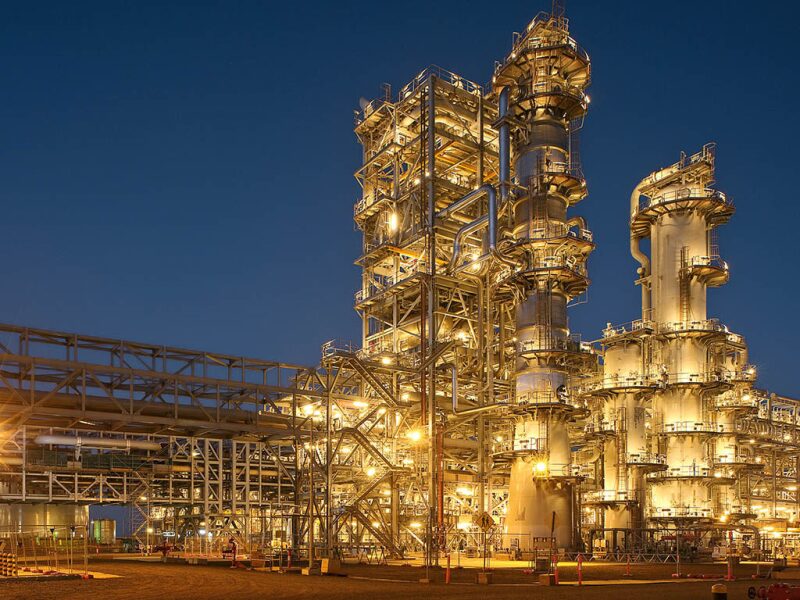The demand for a clean-burning fuel to heat homes and generate electricity has led to a surge in demand for natural gas. In response, the energy industry will see an ongoing increase in the need for liquefied natural gas (LNG) to move supplies of the world’s stranded gas reserves to market.
Michael Choi, a process engineering fellow at ConocoPhillips, said the world has as much as 2,500 Tcf of stranded natural gas that could be moved to market if it can reach a liquefaction facility. Stranded gas includes all reserves that are available, but are isolated from the infrastructure needed to bring it to market. Although all traditional LNG processing plants are onshore, there are novel offshore and near-shore designs under development, he said.
Choi spoke during a recent SPE webinar titled, “LNG Basics for Petroleum Engineers,” which was part of the Distinguished Lecturer Program. By cooling natural gas to -162°C, engineers can reduce its volume by a ratio of 600 to 1—600 ft3 of natural gas is reduced to 1 ft3 of liquid—and pump it into a cryogenic container on a ship, where it can be moved long distances at sea more economically than a pipeline. To do so requires large plants that can take advantage of economies of scale. “The bigger the train, the better the economics,” he said.
The technology for natural gas liquefaction is similar to the air conditioning units in most homes, which include a compressor to circulate the refrigerant, a condenser, and an evaporator to extract the heat to chill and condense the gas. The difference is size. A typical house compressor requires from 5 kW to 10 kW of energy, while an industrial compressor at a typical LNG plant typically requires from 40 MW to 100 MW. “It’s much, much larger in scale,” Choi said.
Before the gas is cooled, however, engineers must remove its impurities, including water vapor, carbon dioxide (CO2), mercury, and hydrogen sulfide (H2S). The gas stream frequently goes through an amine treatment system to remove CO2 and H2S. The limitation for CO2 in LNG is less than 50 ppm (the limit for CO2 in a pipeline is 1% to 2%). At concentrations higher than 50 ppm, there is a risk of CO2 condensing and plugging in the cryogenic heat exchanger. If the concentration of H2S is too high, the plant may need a Claus sulfur recovery unit to convert the H2S into elemental sulfur, which is later sold to make fertilizer. (Claus is a widely used process that combines oxygen with H2S to produce elemental sulfur and water.) The threshold limit for H2S content in LNG sales gas for international markets is 4 ppm.
Every LNG plant has a molecular sieve dehydration system to remove or reduce moisture content in the LNG feed to less than 100 ppb. Like CO2, moisture can condense and plug a cryogenic heat exchanger. In addition, nearly every LNG plant has some type of mercury recovery unit. Mercury is corrosive to aluminum, the primary material used in the design of cryogenic heat exchangers, he said.
LNG processing engineers also need to remove natural gas liquids from gas streams. Butanes and heavier liquids must be taken out to prevent them from freezing in the cryogenic section of the plant.
Because most LNG plants are located in regions where there is no ethane market, the ethane gets cycled back into the gas, which makes it difficult to meet the heating limits for North American and European gas. (If the gas is marketed in North America and Europe, it usually has a maximum heat limit of about 1,070 Btu/scf of gas). If ethane is cycled back into the gas feed, it pushes the LNG close to the heat limit. This forces the LNG processing engineers to strip out almost all of the propane to meet the maximum heat specification. The liquids removed from the gas stream are generally sold separately from the LNG, Choi said.
Once the operator removes the impurities and heavier gas hydrocarbons from the gas feed, it moves to the liquefaction facility. The goal is to remove heat from the gas using a refrigerant with the highest possible temperature. The gas goes through a series of stages, which reduce temperature using different refrigerants, starting with an air/water mixture, then propane, then ethylene, and finally, methane or nitrogen. “As we get colder, the cost of removing each Btu of heat goes up exponentially,” Choi said.
The commercially available liquefaction processes are cascade, single mixed refrigerant, propane precooled mixed refrigerant, double mixed refrigerant, and nitrogen.
The optimized cascade process is a technology licensed by ConocoPhillips and constructed by Bechtel (Fig. 1). The process includes three stages of propane chilling, two stages of ethane refrigeration, and three stages of methane refrigeration.

The methane precooled mixed refrigerant process is the most widely used of all cooling processes. Its technology is licensed by Air Products and Chemicals (APCI) and the plants are built by several companies: KBR, Chiyoda, JGC, and Foster Wheeler. This technology has been in use since 1972, when the first plant in Algeria began its operations. A drawback of this technology is that it cannot be scaled beyond a certain point, Choi said.
To offset the drawbacks of limited scale, APCI developed the AP-X process, which can process up to 8 MTPA of LNG per plant (Fig. 2). This system uses propane to precool the gas and a mixed refrigerant to condense the gas, he said. The Qatar Gas II project, which started production in 2009, was the first plant built using this technology. Six other plants using this technology are under development in Qatar.

This webinar can be viewed at https://webevents.spe.org/products/lng-basics-for-petroleum-engineers-spe-distinguished-lecturer.

